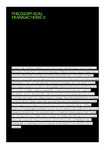Hot-headed peckers: thermographic changes during aggression among juvenile pheasants ( Phasianus colchicus )
| dc.contributor.author | Knoch, S | |
| dc.contributor.author | Whiteside, Mark | |
| dc.contributor.author | Madden, JR | |
| dc.contributor.author | Rose, PE | |
| dc.contributor.author | Fawcett, TW | |
| dc.date.accessioned | 2022-01-12T15:06:07Z | |
| dc.date.available | 2022-01-12T15:06:07Z | |
| dc.date.issued | 2022-02-28 | |
| dc.identifier.issn | 0962-8436 | |
| dc.identifier.issn | 1471-2970 | |
| dc.identifier.other | ARTN 20200442 | |
| dc.identifier.uri | http://hdl.handle.net/10026.1/18550 | |
| dc.description.abstract |
<jats:p> In group-living vertebrates, dominance status often covaries with physiological measurements (e.g. glucocorticoid levels), but it is unclear how dominance is linked to dynamic changes in physiological state over a shorter, behavioural timescale. In this observational study, we recorded spontaneous aggression among captive juvenile pheasants ( <jats:italic>Phasianus colchicus</jats:italic> ) alongside infrared thermographic measurements of their external temperature, a non-invasive technique previously used to examine stress responses in non-social contexts, where peripheral blood is redirected towards the body core. We found low but highly significant repeatability in maximum head temperature, suggesting individually consistent thermal profiles, and some indication of lower head temperatures in more active behavioural states (e.g. walking compared to resting). These individual differences were partly associated with sex, females being cooler on average than males, but unrelated to body size. During pairwise aggressive encounters, we observed a non-monotonic temperature change, with head temperature dropping rapidly immediately prior to an attack and increasing rapidly afterwards, before returning to baseline levels. This nonlinear pattern was similar for birds in aggressor and recipient roles, but aggressors were slightly hotter on average. Our findings show that aggressive interactions induce rapid temperature changes in dominants and subordinates alike, and highlight infrared thermography as a promising tool for investigating the physiological basis of pecking orders in galliforms. </jats:p> <jats:p>This article is part of the theme issue ‘The centennial of the pecking order: current state and future prospects for the study of dominance hierarchies’.</jats:p> | |
| dc.format.extent | 20200442- | |
| dc.format.medium | Print-Electronic | |
| dc.language | en | |
| dc.language.iso | en | |
| dc.publisher | The Royal Society | |
| dc.subject | aggression | |
| dc.subject | dominance hierarchy | |
| dc.subject | infrared thermography | |
| dc.subject | pecking order | |
| dc.subject | social defeat | |
| dc.subject | stress-induced hyperthermia | |
| dc.title | Hot-headed peckers: thermographic changes during aggression among juvenile pheasants ( Phasianus colchicus ) | |
| dc.type | journal-article | |
| dc.type | Journal Article | |
| dc.type | Observational Study | |
| dc.type | Research Support, Non-U.S. Gov't | |
| plymouth.author-url | https://www.webofscience.com/api/gateway?GWVersion=2&SrcApp=PARTNER_APP&SrcAuth=LinksAMR&KeyUT=WOS:000740722200018&DestLinkType=FullRecord&DestApp=ALL_WOS&UsrCustomerID=11bb513d99f797142bcfeffcc58ea008 | |
| plymouth.issue | 1845 | |
| plymouth.volume | 377 | |
| plymouth.publication-status | Published | |
| plymouth.journal | Philosophical Transactions of the Royal Society B: Biological Sciences | |
| dc.identifier.doi | 10.1098/rstb.2020.0442 | |
| plymouth.organisational-group | /Plymouth | |
| plymouth.organisational-group | /Plymouth/Faculty of Science and Engineering | |
| plymouth.organisational-group | /Plymouth/Faculty of Science and Engineering/School of Biological and Marine Sciences | |
| plymouth.organisational-group | /Plymouth/Users by role | |
| plymouth.organisational-group | /Plymouth/Users by role/Academics | |
| dc.publisher.place | England | |
| dcterms.dateAccepted | 2021-10-28 | |
| dc.rights.embargodate | 2022-1-14 | |
| dc.identifier.eissn | 1471-2970 | |
| dc.rights.embargoperiod | Not known | |
| rioxxterms.versionofrecord | 10.1098/rstb.2020.0442 | |
| rioxxterms.licenseref.uri | http://www.rioxx.net/licenses/all-rights-reserved | |
| rioxxterms.licenseref.startdate | 2022-02-28 | |
| rioxxterms.type | Journal Article/Review |


